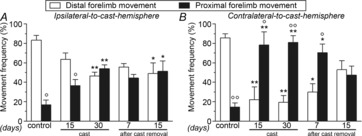Figure 5. Unilateral forelimb casting changed the type of intracortical microstimulation-evoked movements.

Effects of cast immobilization on the frequency (percentage of total forelimb movements) of distal and proximal forelimb movements in the ipsilateral-to-cast (A) and contralateral-to-cast (B) hemispheres. All measurements were obtained in control rats, and in experimental rats after 15 and 30 days of cast immobilization, and at 7 and 15 days after cast removal (following 30 days of cast immobilization). Data are expressed as the mean ± s.e.m. of five measurements per group. Note that in both hemispheres, during and after casting, the recruitment of proximal movements increased at the expense of distal movements. Statistical results: A, distal: H = 11.24, P = 0.0240; proximal: H = 11.24, P = 0.0240; B, distal: H = 15.51, P = 0.0038; proximal: H = 15.51, P = 0.0038. *P < 0.05, **P < 0.01 different from control (Kruskal–Wallis test followed by Dunn's test); °P < 0.05, °°P < 0.01 different from distal forelimb movement (Mann–Whitney test).
